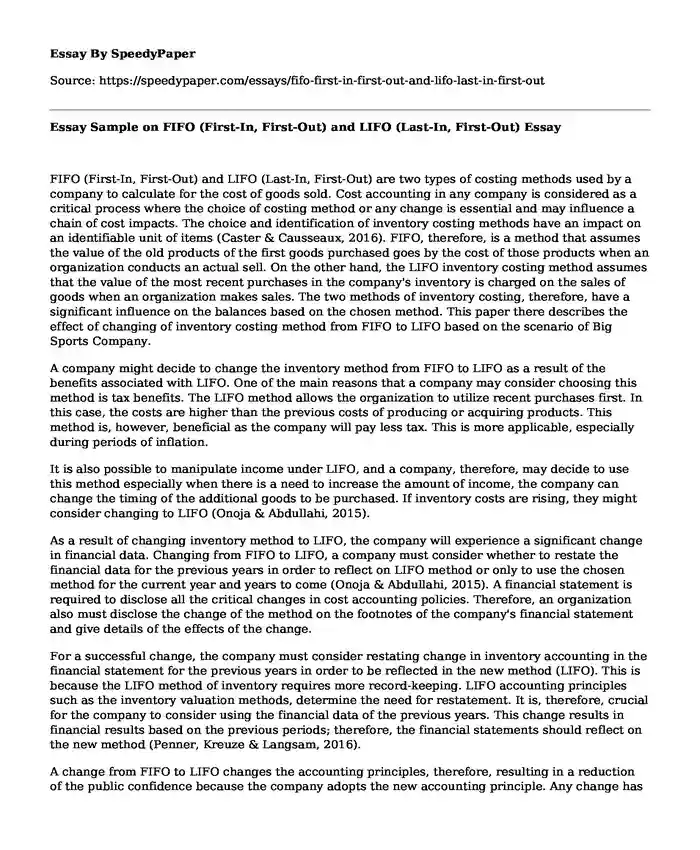
| Type of paper: | Course work |
| Categories: | Sales Financial analysis Leadership management |
| Pages: | 3 |
| Wordcount: | 668 words |
FIFO (First-In, First-Out) and LIFO (Last-In, First-Out) are two types of costing methods used by a company to calculate for the cost of goods sold. Cost accounting in any company is considered as a critical process where the choice of costing method or any change is essential and may influence a chain of cost impacts. The choice and identification of inventory costing methods have an impact on an identifiable unit of items (Caster & Causseaux, 2016). FIFO, therefore, is a method that assumes the value of the old products of the first goods purchased goes by the cost of those products when an organization conducts an actual sell. On the other hand, the LIFO inventory costing method assumes that the value of the most recent purchases in the company's inventory is charged on the sales of goods when an organization makes sales. The two methods of inventory costing, therefore, have a significant influence on the balances based on the chosen method. This paper there describes the effect of changing of inventory costing method from FIFO to LIFO based on the scenario of Big Sports Company.
A company might decide to change the inventory method from FIFO to LIFO as a result of the benefits associated with LIFO. One of the main reasons that a company may consider choosing this method is tax benefits. The LIFO method allows the organization to utilize recent purchases first. In this case, the costs are higher than the previous costs of producing or acquiring products. This method is, however, beneficial as the company will pay less tax. This is more applicable, especially during periods of inflation.
It is also possible to manipulate income under LIFO, and a company, therefore, may decide to use this method especially when there is a need to increase the amount of income, the company can change the timing of the additional goods to be purchased. If inventory costs are rising, they might consider changing to LIFO (Onoja & Abdullahi, 2015).
As a result of changing inventory method to LIFO, the company will experience a significant change in financial data. Changing from FIFO to LIFO, a company must consider whether to restate the financial data for the previous years in order to reflect on LIFO method or only to use the chosen method for the current year and years to come (Onoja & Abdullahi, 2015). A financial statement is required to disclose all the critical changes in cost accounting policies. Therefore, an organization also must disclose the change of the method on the footnotes of the company's financial statement and give details of the effects of the change.
For a successful change, the company must consider restating change in inventory accounting in the financial statement for the previous years in order to be reflected in the new method (LIFO). This is because the LIFO method of inventory requires more record-keeping. LIFO accounting principles such as the inventory valuation methods, determine the need for restatement. It is, therefore, crucial for the company to consider using the financial data of the previous years. This change results in financial results based on the previous periods; therefore, the financial statements should reflect on the new method (Penner, Kreuze & Langsam, 2016).
A change from FIFO to LIFO changes the accounting principles, therefore, resulting in a reduction of the public confidence because the company adopts the new accounting principle. Any change has consequences on financial statements hence affecting financial reporting. When calculating the information necessary for retrospective application as a result of any change leads to more complex financial reporting circumstances because multiple years are involved.
References
Caster, A. B., & Causseaux, W. K. (2016). The Impact of Inventory Valuation Methods on Corporate Financial Reports. Journal of Business Case Studies (Online), 12(3), 125.
Onoja, E. E., & Abdullahi, Y. U. (2015). Inventory valuation practices and reporting: Nigerian textile industry experience. Mediterranean Journal of Social Sciences, 6(4), 74.
Penner, J., Kreuze, J., & Langsam, S. (2016). Analysis of Simplification of Accounting Initiative for Inventory and Update of Other Simplification Proposals. Journal of Corporate Accounting & Finance, 27(4), 9-12.
Cite this page
Essay Sample on FIFO (First-In, First-Out) and LIFO (Last-In, First-Out). (2023, Mar 22). Retrieved from https://speedypaper.net/essays/fifo-first-in-first-out-and-lifo-last-in-first-out
Request Removal
If you are the original author of this essay and no longer wish to have it published on the SpeedyPaper website, please click below to request its removal:
- Free Essay on Leadership and Leadership Theories
- Free Essay about NAB Company: Operation, Technology, and Management Plan
- Free Paper Sample on Leadership Style, Work Balance, Learning and Development, and Employee Engagement
- Essay Sample for You: Origin and Aims of the 1944 Education Act
- Biographical Study on Lu Xun, Literary Essay Sample
- Free Essay Sample: Prince Sports, Inc.
- Free Essay: The Most Important Piece From the Students' Experiences
Popular categories




